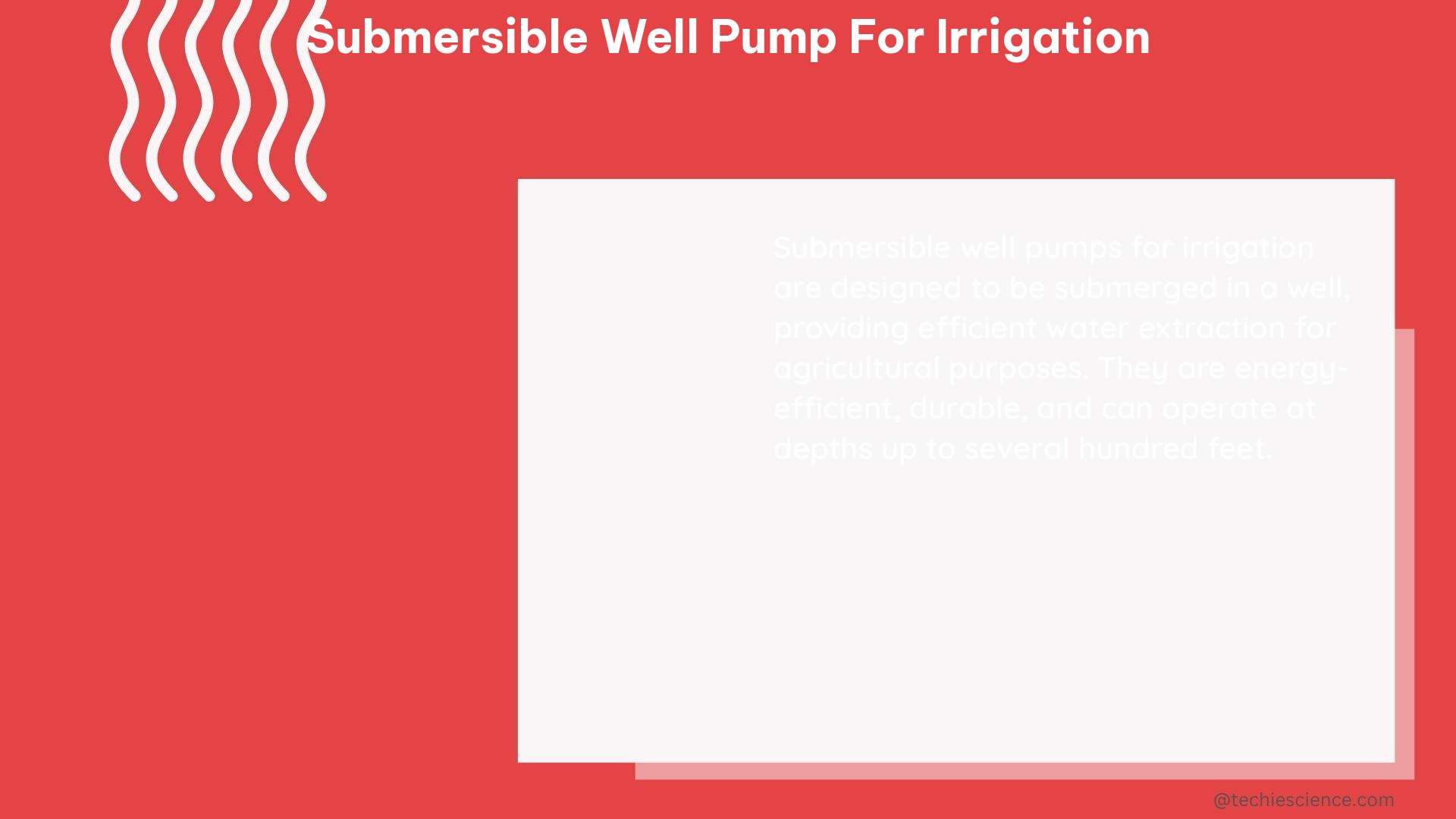Submersible well pumps are a critical component of many irrigation systems, responsible for drawing water from underground sources and delivering it to the surface for distribution. Understanding the key factors that influence the selection and performance of these pumps is essential for ensuring efficient and effective irrigation. In this comprehensive guide, we will delve into the technical details and quantifiable data points that are crucial when choosing and maintaining a submersible well pump for irrigation.
Pump Size and Capacity
The size of a submersible well pump is typically measured in horsepower (HP), which indicates the pump’s ability to lift water to a certain height and flow at a specific volume. Generally, a 1 HP pump can lift water to a height of around 230 feet and flow at a rate of approximately 10 gallons per minute (GPM), while a 5 HP pump can lift water to a height of around 1,150 feet and flow at a rate of around 48 GPM.
When selecting a pump size, it’s important to consider the depth of the well and the desired flow rate for your irrigation system. For example, a 1 HP pump may be sufficient for a well that is 100 feet deep, but a 5 HP pump may be required for a well that is 500 feet deep. Additionally, the flow rate required for your irrigation system will depend on the size of the area being irrigated and the type of irrigation system being used (e.g., drip irrigation vs. sprinkler system).
Well Depth and Water Level

The depth of the well is a critical factor in determining the size and type of pump required. Deeper wells require more powerful pumps to lift the water to the surface. As a general rule, a 1 HP pump may be sufficient for a well that is 100 feet deep, while a 5 HP pump may be required for a well that is 500 feet deep.
The water level in the well can also affect the pump size and type required. If the water level is consistently low, a pump with a higher lift capacity may be necessary to ensure adequate water flow. Conversely, if the water level is consistently high, a pump with a lower lift capacity may be sufficient.
Total Dynamic Head (TDH)
Total Dynamic Head (TDH) is a measure of the total height that the water needs to be lifted, including the vertical lift from the pump to the surface, the friction loss in the pipes, and the pressure required at the point of use. TDH is typically measured in feet or meters and should be matched to the capacity of the pump.
To calculate the TDH, you’ll need to consider the following factors:
– Vertical lift: The distance from the pump to the surface
– Friction loss: The pressure drop due to the resistance of the pipes and fittings
– Pressure required at the point of use: The pressure needed for the irrigation system to function properly
By accurately determining the TDH, you can ensure that the pump you select is capable of delivering the required water flow and pressure to your irrigation system.
Pump Efficiency
The efficiency of a submersible well pump is a measure of how much of the energy used by the pump is actually used to lift the water. Pump efficiency is typically expressed as a percentage, with higher efficiency values indicating that more of the input energy is being converted into useful work.
Factors that can affect pump efficiency include:
– Impeller design
– Motor efficiency
– Bearing and seal performance
– Pipe and fitting configuration
When selecting a submersible well pump, it’s important to choose a model with the highest possible efficiency to minimize energy costs and maximize the return on your investment.
Maintenance and Troubleshooting
Regular maintenance is essential for ensuring that a submersible well pump continues to operate efficiently and effectively. This includes:
– Checking and replacing worn parts, such as the impeller, bearings, and seals
– Cleaning the intake screen and check valves
– Monitoring the pump’s performance over time to identify potential issues
By proactively maintaining your submersible well pump, you can extend its lifespan, reduce energy costs, and avoid costly breakdowns or repairs.
In the event of a problem with your submersible well pump, it’s important to troubleshoot the issue quickly to minimize downtime and ensure the continued operation of your irrigation system. Common issues that may arise include:
– Reduced water flow or pressure
– Increased energy consumption
– Unusual noises or vibrations
– Pump failure or shutdown
By understanding the underlying causes of these problems and taking appropriate corrective actions, you can keep your submersible well pump running at peak performance.
Conclusion
Submersible well pumps are a critical component of many irrigation systems, and understanding the key factors that influence their selection and performance is essential for ensuring efficient and effective water delivery. By considering the pump size, well depth, water level, TDH, efficiency, and maintenance requirements, you can choose the right submersible well pump for your irrigation needs and keep it running at its best for years to come.
References:
- Sizing a Water Well Submersible Pump
- Improve Irrigation System Performance with Proper Pump Maintenance
- Irrigation Pumps
- Selecting the Correct Pump for Your Irrigation System
- Optimization of Submersible Pump Performance for Irrigation Systems

The lambdageeks.com Core SME Team is a group of experienced subject matter experts from diverse scientific and technical fields including Physics, Chemistry, Technology,Electronics & Electrical Engineering, Automotive, Mechanical Engineering. Our team collaborates to create high-quality, well-researched articles on a wide range of science and technology topics for the lambdageeks.com website.
All Our Senior SME are having more than 7 Years of experience in the respective fields . They are either Working Industry Professionals or assocaited With different Universities. Refer Our Authors Page to get to know About our Core SMEs.